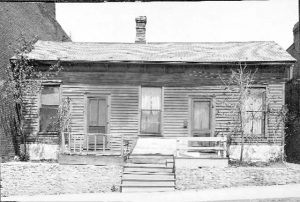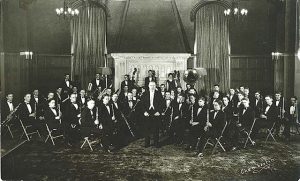You may remember Prince’s song, “Party Like It’s 1999,” which was popular as the new millennium approached. Well, Northfielders were in the mood to party right before the turn of the century in 1899, not only because 1900 was drawing nigh, but also because at long last a new, modern playhouse was opening in town. On Dec. 26, a play called “The Red Cockade” was the first event at the Ware Auditorium at the corner of Washington and 4th streets, now known as The Grand Event Center.

The Northfield News was ecstatic in its praise of this new venue for entertainment. The interior of the auditorium, decked in “rich, warm tints, trimmed with white,” was described as a “revelation” to theater goers. A circular lobby opened into the foyer, with cushioned opera chairs on the first floor and front balcony, gallery benches at the rear balcony, two first floor proscenium boxes and two balcony boxes. Hanging from the octagonal dome was “an electric sunlight, finished in blue.” The newspaper gave credit to the Minneapolis architect, Harry Carter, for the plans and lauded the acoustics (favorable to voices and the orchestra), the ventilation and the 33-feet deep stage, “fully lighted with electricity and so wired as to permit of modern lighting effects.” The “cultured and appreciative” opening night audience was “most metropolitan,” and “some handsome costumes were in evidence among the ladies.”
The Northfield Independent chimed in, saying that “Northfield now rejoices in the possession of a place of amusement which is second to none and is one of the handsomest and most complete of any of similar size in the country…One of the first objects which is pointed out with pride to visitors is ‘our new opera house.’”

A.K. Ware addressed the audience at the end of the second act to thank them for their support. Ware was a newcomer to town, attracted by educational opportunities for his nine children. He helped form a steam-powered electric generating plant on W. Water Street and established a breeding farm for trotting horses. In April of 1899, Ware bought land for an opera house and Northfield residents were elated to read the plans he published for it in the Northfield News of July 8. Due to intense public interest, Ware had been persuaded to construct a building that would cost about twice the original estimate of $5,000 to $8,000. Citizens rallied behind a plan to help raise $4,000 to secure the auditorium by buying open-ing night tickets at $10 each.
The opening night play, “The Red Cockade,” was described by the Northfield News as “a romantic comedy-drama laid in 1795 in the bloody days of the French Revolution” involving “the terrible struggle between peasantry and aristocracy.” The star of the traveling company of players was Walker Whiteside, who spoke to the crowd at the end of the third act about arriving by train in Northfield eight hours late, “tired, hungry and I might say sleepy.” He went immediately to the theater to “see that everything was in place, as a sailor would say, shipshape. I was astonished. I was delighted with the new auditorium. I found it was neat, cozy and homelike, something the people of Northfield should be proud of.” He added, “They should express their gratification to Mr. Ware, for getting such a neat and pretty play house.”
Within four months, disaster struck the “neat and pretty play house.” After midnight on April 13, 1900, a fire broke out in the basement of the auditorium and, according to the Northfield News, “before the flames were under control practically the whole interior was wrecked, aggregating a loss of over $7,000.” Time after time the firemen “plunged into smoke too thick for mortal to live in and worked until they were exhausted.” The interior was described as “smoked and blackened,” with fallen plaster and with the opera chairs a total loss, “burned, warped and blistered.” The south end of the foyer and parquet circle were completely destroyed.
Fortunately, damages were covered by insurance and Ware was able to triumphantly reopen the auditorium on June 2 with a performance of Verdi’s “Il Trovatore” by the Boston Lyric Opera Company, starring the renowned tenor Dominico Russo. Despite the expense of this production
(Russo, alone, received a reported payment of $125 a night), Ware kept ticket prices at between 25 cents and a dollar.
A decade later, in the Northfield News of August 20, 1910,Ware listed the theater for sale from his new home in Medford, Oregon. “Will sell at great sacrifice, only $12,000,” he wrote.
“Don’t someone wish to form a company to buy it?” The following March, in a Notice to the Public, Ware announced the closing of the auditorium to all shows, with the exception of the annual class play and high school commencement exercises. Ware thanked the public for past patronage, but he said “the fact remains that I have not received one cent income from it for one year now, although it has cost me nearly $700 to maintain it.”
In June of 1904, the Edison Projectoscope Company of New York City presented in the Ware some of the first public movies seen in Northfield, presaging the auditorium’s future use as The Grand Theater from 1917 to 1985. Today the party atmosphere of 1899 has returned, as The Grand Event Center hosts many festive occasions including wedding receptions and special community events. Northfielders are now partying at The Grand “like it’s 2099.”
Information and photos for this story were found in the archives of the Northfield Historical Society.






